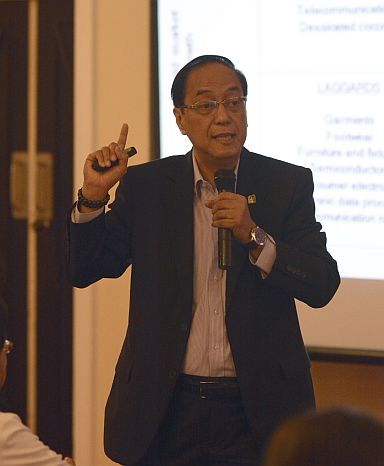Diversify products, streamline processes to hit goals — exec

Senen M. Perlada, Export Development Council executive director, discusses the Philippine Export Development Plan 2015-2017 at a forum yesterday in Cebu City. (CDN PHOTO/CHRISTIAN MANINGO
Exporters need to diversify their products, and government agencies should address bureaucratic bottlenecks in the export industry to achieve the country’s export targets in the next two years.
Export Development Council (EDC) Executive Director Senen Perlada said these two solutions to the issues that will keep the export industry from hitting its targets in the Philippine Export Development Plan (PEDP) 2015-2017 should be aggressively implemented to achieve growth in the industry.
Perlada, however, said he is optimistic of the future of the industry especially with the aggressive implementation of the regionalized PEDP.
“The US$100 billion 2017 target for total exports might be a little more difficult to achieve, but we are very confident about 2016,” said Perlada during the highlight of his presentation of the new PEDP to export stakeholders in Cebu yesterday.
“We expect growth in exports even with January this year down. This is too short a period of time to generalize,” he said.
The total export revenues forecasted in the PEDP for 2016 are between 6.6 and 8.8 percent. Goods export is expected to grow between 5.4 to 8.0 percent, while services are expected to grow from 9.0 to 10.3 percent.
Under the same plan, total export revenues forecasted for 2017 are between 7.7 to 10.6 percent. Goods are expected to grow between 6.7 to 10.0 percent, while services are expected to grow from 7.7 to 10.6 percent.
Lack of diversification in the industry should be addressed.
“The Philippines is concentrated on fewer products and markets,” he said, citing that the largest export markets for the Philippines, namely countries like Japan, United States, China and Hong Kong, make up for more than half of the total exports.
Based on trade mapping conducted by the Export Marketing Bureau (EMB), around 77 percent of the country’s total export products are in failing markets or markets exhibiting decreased growth.
These markets include garments, furniture and fixtures, semiconductors, consumer electrics, travel, financial services and construction.
The large percentage of exports in slow markets also indicates a smaller number of competitive Philippine products in the Asean.
“Only 33 percent of Philippine exports are considered competitive, or have a higher growth in shares compared to world demand. This is a lot lower than Thailand, with 70 percent and Vietnam, with 90 percent,” Peralda said.
The PEDP, the formulation of which was supported by the European Union under the Trade Related Technical Assistance Project 3 (TRTA3), hopes to address these hindrances by providing eight development strategies.
Under the first strategy, six national key markets have already been determined, namely electronics, processed food and beverage, coconut oil, motored vehicle parts, and computer and information services.
Included in the Central Visayas target markets are fashion accessories, gifts, toys and housewares (GTH), and furniture, said Department of Trade and Industry (DTI) Regional Director Asteria Caberte.
Caberte said that while some of these markets fall under those recognized by the EDC to be slow markets, improved trade and exports in these markets will be targeted in these sectors to increase their standing in Philippine export.
“They bring about a lot of employment in Central Visayas, so we cannot just discount them,” she said.
Other export markets the region will be participating in are processed food and beverages, virgin coconut oil, and information technology and business-processes management (IT-BPM).
Aside from that, the DTI 7 has identified several potential markets, including the Middle East and Australia, which have large populations of overseas Filipino workers (OFWs).
To address the bureaucratic bottlenecks issue, the DTI and other export-involved agencies are now required to submit the status of programs they have for export.
“Agencies have to streamline now their processes to make exports easier. The reports will show which agencies implement slowly,” Caberte said.
The other strategies under the PEDP include raising productivity and competitiveness of Philippine enterprises.
Disclaimer: The comments uploaded on this site do not necessarily represent or reflect the views of management and owner of Cebudailynews. We reserve the right to exclude comments that we deem to be inconsistent with our editorial standards.
